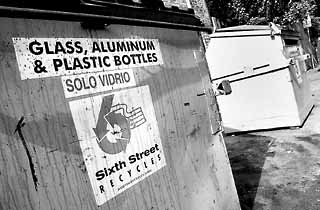Naked City
The Sound of Breaking Recyclers
By Jordan Smith, Fri., Aug. 24, 2001

After a six-month trial, the flagship-program Sixth Street Recycles is coming to an end. And despite its success -- not to mention the fact that more than 90% of what Sixth Street throws away is recyclable material -- it is unclear whether the city plans to adopt the program for widespread use downtown.
The pilot program targeted the 300 block on the north side of East Sixth, substituting recycling containers for several trash bins in the alley behind the businesses -- mostly bars and restaurants -- to collect both glass and cardboard. While no recent data is available, at the end of the first six weeks of the program, the city's Solid Waste Services Dept. reported that more than seven tons of recyclable material was diverted from the landfill, including more than six tons of glass and more than one ton of cardboard.
"Extrapolate that out for a year, and if you had all six blocks of Sixth Street involved, you'd be talking [many more] tons of material," said Jeff Steinborn, a recycling activist who helped create the program and now lives in New Mexico. "By any objective criteria this project has been a great success."
So, with the obvious success and benefits of the program, why wouldn't the city want to adopt it permanently? "The main problem is contamination; plastic getting in with the glass in the Dumpsters," said Solid Waste spokesperson Stephanie Lott. Apparently plastic trash-can liners have been making their way into the glass recycling Dumpsters and in turn getting stuck in the machines the city uses to sort the material.
"Originally [the Solid Waste Dept.] reported that there was a 2% contamination, and that's not bad," said J.D. Porter of the Solid Waste Commission. "I used to be the director at Ecology Action, and I would've killed for that rate." But, as time went on, Porter said, Solid Waste Services Director Willie Rhodes began telling the commission that the contamination levels in the glass recycling were on the rise. "So what Willie says he's going to do is drop [the glass recycling] part of the program."
Porter said the commission has grilled Rhodes on that decision. For one thing, he said, commissioners want to see the updated contamination percentages, but still haven't received any data. In any case, he said, increased contamination only confirms that some of the business owners are not following the recycling rules.
"Maybe they're not keeping the Dumpsters locked, which they're supposed to do," Porter said. "But it's clearly not coming from all places, and that's key too. This is not a reason to kill this whole project."
Indeed, a little contamination seems a small problem to contend with in the face of the potential good the project could do.
"We are committed to providing cost-effective services that protect the public health, the environment and the aesthetic quality of the community," reads the Solid Waste Services Web site. "That means keeping as much material as possible out of the landfill."
Jerry Hendrix, another Solid Waste spokesperson, says no final decision has been made. "We have not made a determination yet. We have until the end of the month and then we'll weigh the pros and cons," he said. "We're pretty comfortable with the paper, it's pretty clean. But we still have to look at the glass and see what it's going to take to get that contamination removed, then we'll have to do a cost-benefit analysis."
Hendrix said that when looking at how much material has been diverted from the landfill, the department actually looks at volume (meaning physical space) and not weight. Volume, he said, is how much actual space in the landfill the material takes up, and in this case, the cardboard/paper materials take up more space. "Paper is where the real opportunity is," he said. "What most people don't realize is that all that glass that comes out of the bars comes in [to them] in a big box."
For advocates like Steinborn, this makes very little sense. "It sounds like a little bit of propaganda they're laying down there. The cardboard is about 20% of what those bars have, and the glass is about 80%. So that's like saying 20% is more important. It doesn't make sense," said Steinborn. "He's just saying that because the cardboard is an easy deal for them. It's asinine."
Porter said he thinks the deal could still be saved if downtown business owners and residents contact the department to express their support for the project. "They need to get on the phone and tell Willie they want it," he said. "When those garbage trucks come down the alleys for pickup, [the sound of crashing glass] is all you can hear for many blocks. That's not something we need in our landfill."
Got something to say on the subject? Send a letter to the editor.








